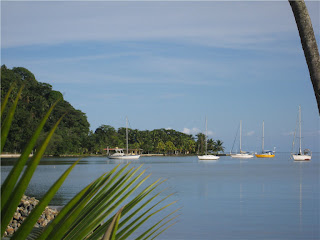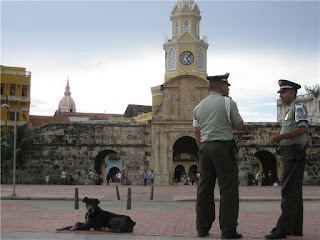skip to main |
skip to sidebar
 Rafting is really for wimps who have never learned to white-water kayak. It is so perfect for me. A trip on the Rio Suarez was crazy. With names like the Devil's Throat and Labyrinth 1&2, the class IV and V+ rapids were explosive and heart-stopping.
Rafting is really for wimps who have never learned to white-water kayak. It is so perfect for me. A trip on the Rio Suarez was crazy. With names like the Devil's Throat and Labyrinth 1&2, the class IV and V+ rapids were explosive and heart-stopping.
Check out the trip here:
http://www.youtube.com/watch?v=HGDatODUecQ

Fancy driving to South America? Well the Pan American Hwy is not so Pan American: there is no road link between Central & South America. About 200km of inhospitable jungle, swamp and banditos separate Panama and Colombia. Known as the Darien Gap, Scotland bet the farm on colonizing the region in 1698; the ensuing financial ruin forced its amalgamation with England 9 years later. A National Geographic expedition actually did drive the Gap in 1961 but no one since.
Dame tu dinero o te voy a matar! DAME TU DINERO O TE VOY A MATAR!
Give me your money or I'm going to kill you!
Lucky I didn't know enough Spanish to understand what he was shouting. On a dark Sunday night, on a quiet country road, the town's cocaine addict had a shot at relieving me and my pal, Matt, of our money. A strong, shirtless black guy, he came out of nowhere, held what we thought was a machete and pulled me to the ground. He got nothing in the end, 'cept arrested.
'Lindo' is the Spanish word for lovely or pretty. For me, not so much.

To travel cheaply is to travel rough: local buses, basic restaurants, cheap hostels and and simple hotels where quality can vary to the extreme. The best are spotlessly clean, quaint and comfy and might include a bathroom, hot water, air-con, a view, a patio, hammocks, a softish mattress, drinking water, a swimming pool or maybe a TV.
Sure, sure. More often, its shared dorms with noisy, stinky boys and messy girls, cold water showers, no toilet seat, 4am roosters, 5am barking dogs, 6am transport trucks, a dangerously old ceiling fan, and dirty bathrooms.
 My worst room (so far) was in Panama. It looked OK to start then I found mouse droppings under the bed that attracted many large, sinfully ugly cockroaches. The bathroom was infested with mosquitoes and the shower, tap and toilet all spurted thick, black water. At night, the room filled with mossies and boom boom music from the neighbor next door. The cost: an outrageous $12.
My worst room (so far) was in Panama. It looked OK to start then I found mouse droppings under the bed that attracted many large, sinfully ugly cockroaches. The bathroom was infested with mosquitoes and the shower, tap and toilet all spurted thick, black water. At night, the room filled with mossies and boom boom music from the neighbor next door. The cost: an outrageous $12.









 Rafting is really for wimps who have never learned to white-water kayak. It is so perfect for me. A trip on the Rio Suarez was crazy. With names like the Devil's Throat and Labyrinth 1&2, the class IV and V+ rapids were explosive and heart-stopping.
Rafting is really for wimps who have never learned to white-water kayak. It is so perfect for me. A trip on the Rio Suarez was crazy. With names like the Devil's Throat and Labyrinth 1&2, the class IV and V+ rapids were explosive and heart-stopping.




















 In China, it was rare to see any bugs, never mind any wildlife: it was as if they had all been vacuumed up and eaten. Hmm... Central America was the opposite. Despite widespread deforestation for the (asinine) ranching of cattle, the region was full of cool bugs and critters. The climate is so moist and diverse that grass even grows thick on the overhead power lines.
In China, it was rare to see any bugs, never mind any wildlife: it was as if they had all been vacuumed up and eaten. Hmm... Central America was the opposite. Despite widespread deforestation for the (asinine) ranching of cattle, the region was full of cool bugs and critters. The climate is so moist and diverse that grass even grows thick on the overhead power lines.






 My worst room (so far) was in Panama. It looked OK to start then I found mouse droppings under the bed that attracted many large, sinfully ugly cockroaches. The bathroom was infested with mosquitoes and the shower, tap and toilet all spurted thick, black water. At night, the room filled with mossies and boom boom music from the neighbor next door. The cost: an outrageous $12.
My worst room (so far) was in Panama. It looked OK to start then I found mouse droppings under the bed that attracted many large, sinfully ugly cockroaches. The bathroom was infested with mosquitoes and the shower, tap and toilet all spurted thick, black water. At night, the room filled with mossies and boom boom music from the neighbor next door. The cost: an outrageous $12.

